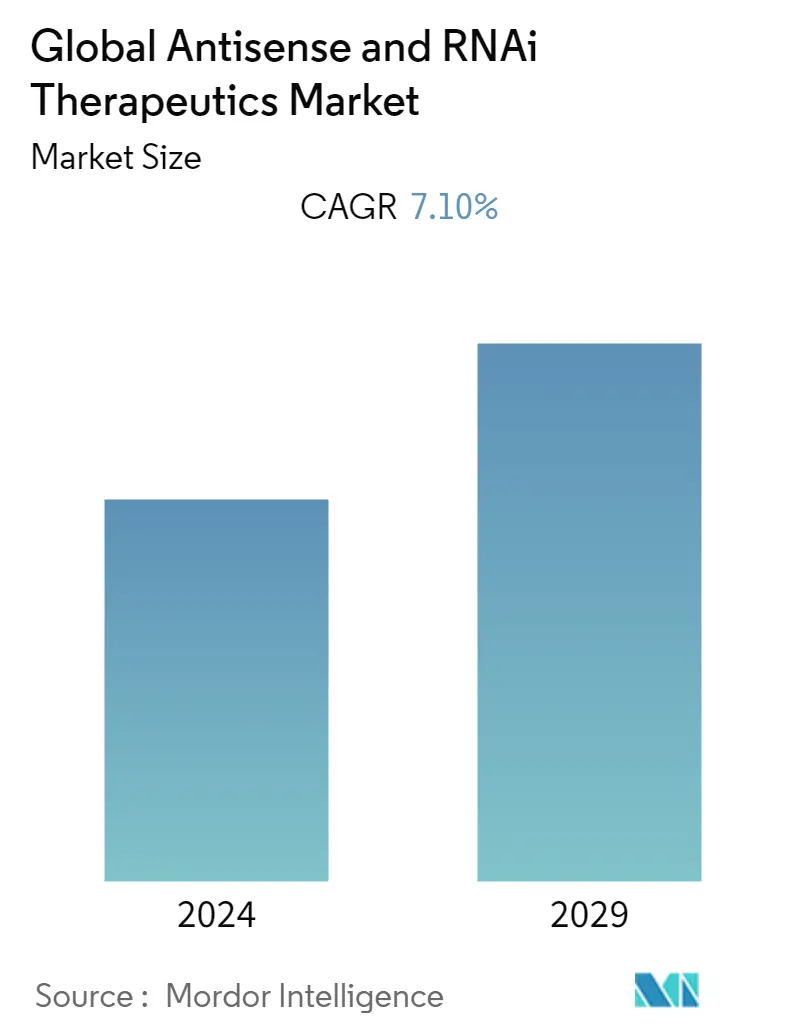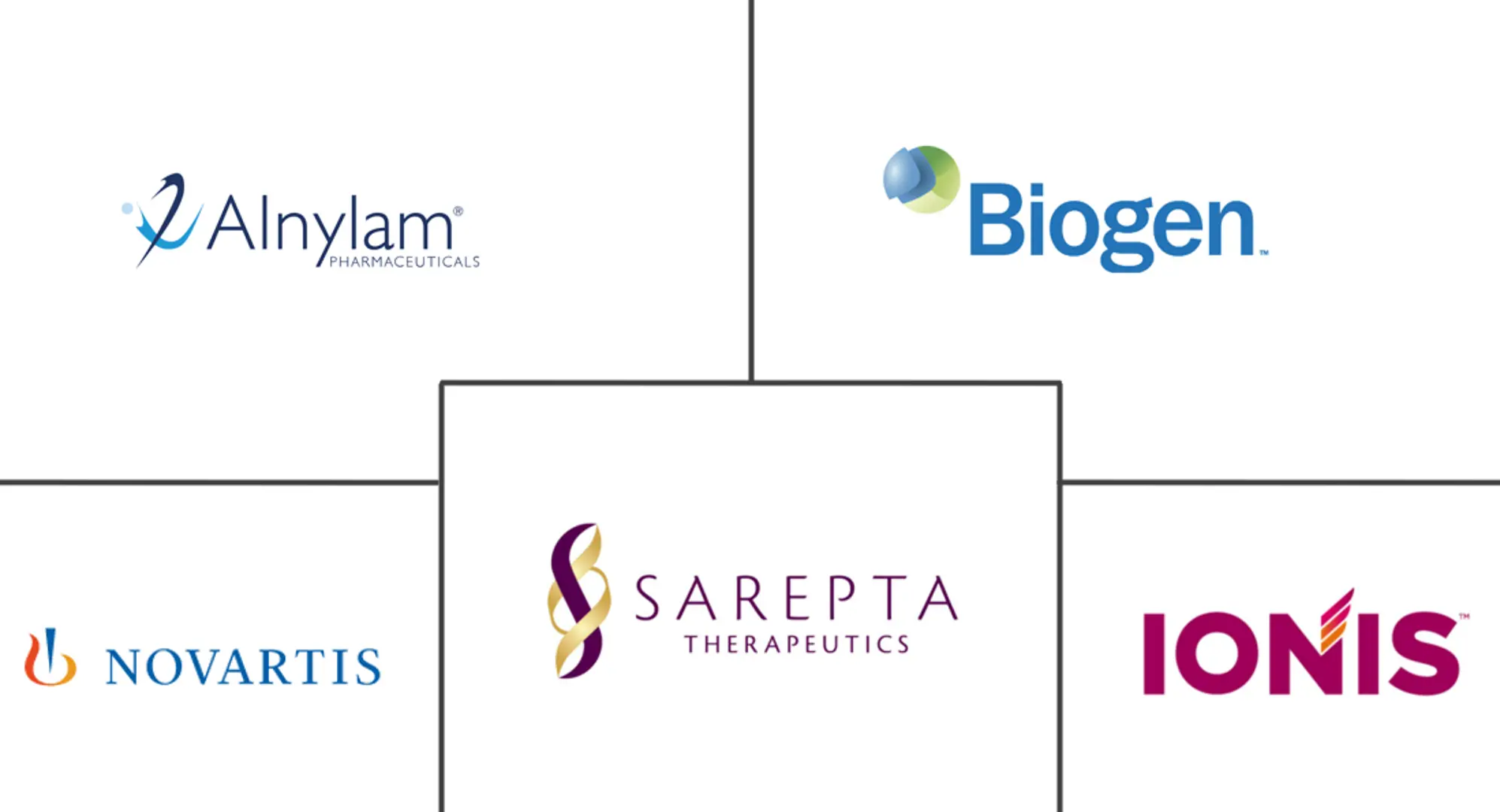Market Size of Global Antisense and RNAi Therapeutics Industry

| Study Period | 2019 - 2029 |
| Base Year For Estimation | 2023 |
| CAGR | 7.10 % |
| Fastest Growing Market | Asia-Pacific |
| Largest Market | North America |
| Market Concentration | High |
Major Players
*Disclaimer: Major Players sorted in no particular order |
Need a report that reflects how COVID-19 has impacted this market and its growth?
Antisense & RNAi Therapeutics Market Analysis
The antisense and RNAi therapeutics market is expected to register a CAGR of 7.1% over the forecast period, 2022-2027.
The COVID-19 pandemic led to seriously deleterious effects on public health systems in many countries. For instance, the healthcare industry was burdened with pandemic crisis management. Furthermore, worldwide lockdowns were imposed to curb the viral outbreak. This in turn led to a shortage of healthcare staff across the globe. Similarly, the pharmaceuticals' manufacturing activities and supply chain worldwide. were also obstructed. In addition, the Antisense and RNAi therapeutics market also suffered substantial losses during the COVID-19 pandemic. There was a sharp decline in the outpatient services offered in hospitals and clinics during the pandemic. Thus, patients receiving treatment for rare genetic conditions such as spinal muscular atrophy (SMA), acute hepatic porphyria, Duchenne muscular dystrophy (DMD), and others experienced delayed drug infusion or disruptions in drug infusion services provided by the healthcare staff. Hence, this leads to a decrease in demand for antisense and RNAi therapeutics. For instance, according to a survey finding released by National Organization for Rare Disorders, Inc. (NORD) in May 2020 in the United States, 74% of patients suffering from rare diseases had a medical appointment canceled. Similarly, according to a survey conducted by the Rare Diseases Clinical Research Network (RDCRN) in the year 2020, only a few patients suffering from rare diseases were able to get an appointment with a medical provider. Thus, the decline in hospital visits during the pandemic impacted the growth of the studied market.
The major factor that leads to the growth of the studied market includes better therapeutic outcomes for rare diseases with the use of antisense and RNAi therapeutics. Furthermore, other factors such as the surge in R&D funding coupled with the presence of promising pipeline products also drive the growth of the market.
RNAi therapeutics are based on a technology that works by preventing cells from producing a specific protein that contributes to disease. Furthermore, this technology is also called gene silencing technology. Some of these rare diseases include spinal muscular atrophy, heterozygous familial hypercholesterolemia (HeFH), acute hepatic porphyria, and others. Hence, this technique has improved the treatment options for rare diseases. For instance, the siRNA therapies identify and bind to the disease-causing mRNA leading to its destruction. Hence, this renders RNAi therapeutics as highly target specific and selective making them a preferred and advanced treatment option for rare diseases. Thus, this leads to a surge in demand for RNAi therapeutics, thereby driving the growth of the market.
In addition, the treatment options available for rare disease across the world is limited. Hence, there has been a gradual increase in the funding related to research activities associated with the discovery of new therapies for rare diseases. For instance, in January 2022, the Food and Drug Administration Office of Orphan Products Development (OOPD) announced the availability of funds to support studies for rare diseases and conditions. In addition, these studies are also expected to provide data to the FDA contributing to the approval of new products, or new indications for already marketed products. Hence, this is expected to lead to a surge in R&D activities related to antisense and RNAi therapeutics for rare diseases. Furthermore, the presence of strong pipeline products which are expected to be launched during the forecast period also drives the growth of the market. For instance, AB-729 is an RNAi therapeutic candidate which is currently being studied by Arbutus Biopharma. Furthermore, AB-729 is in Phase II of clinical trials and is being studied for its therapeutic action in Hepatitis B patients. Similarly, ISTH0036 is another RNAi therapeutic being studied by Isarna Therapeutics GmbH. The drug candidate is present in phase II of clinical trials and is being studied for diabetic macular edema. In addition, GS-101 (Aganirsen) is an antisense oligonucleotide studied by Gene Signal International SA. The drug candidate is currently in phase III of a clinical trial for keratoplasty rejection. Thus, these drug candidates are expected to hit the market in near future. Furthermore, this is expected to lead to a surge in demand for this novel RNAi and antisense therapeutics thereby driving the growth of the market.
